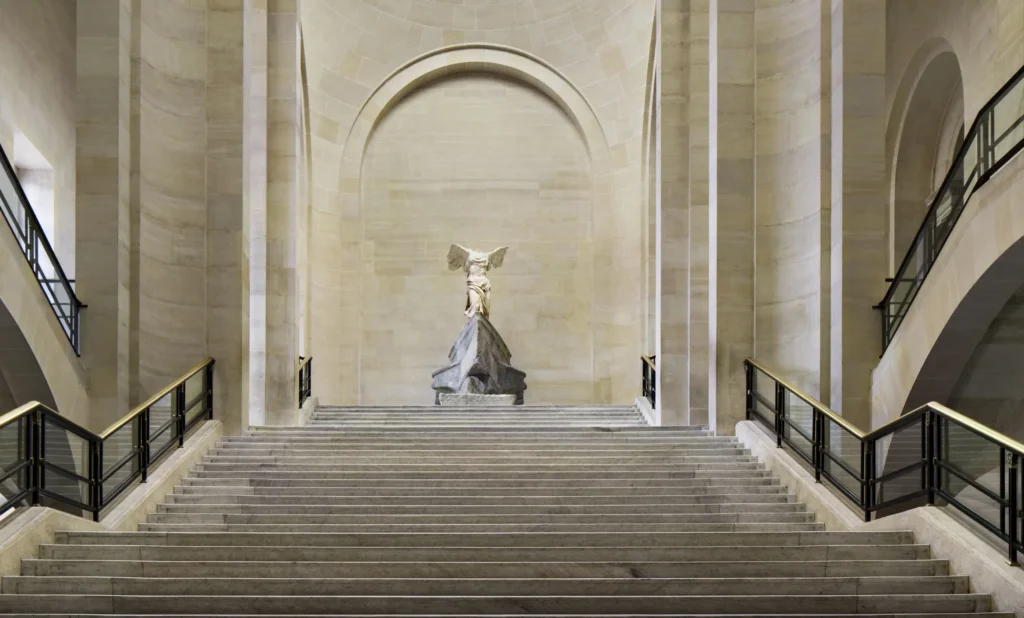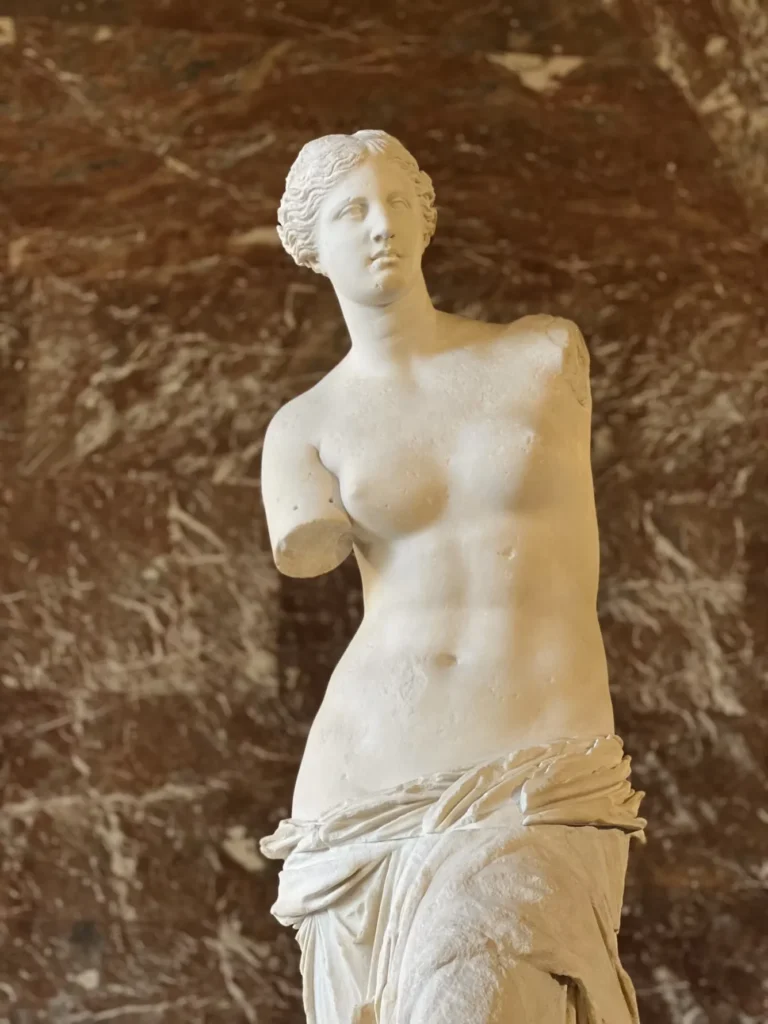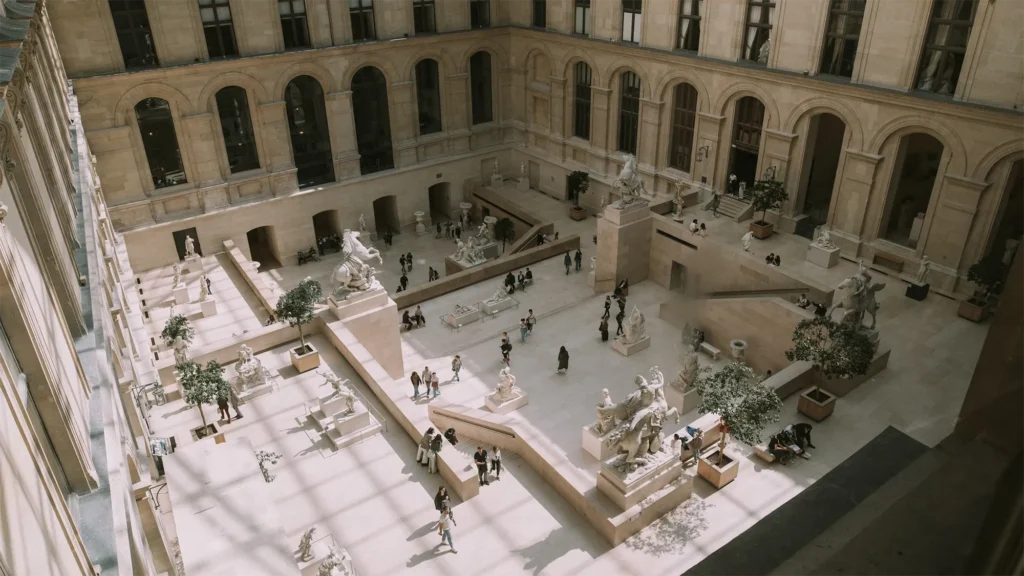You stand beneath the Louvre’s glass pyramid, the morning sun catching its angles in a quiet shimmer. Around you, the world buzzes — cameras click, footsteps echo, ticket queues hum with anticipation. It’s magnificent. It’s overwhelming. And you’re here on your own.
But that’s not a disadvantage. It’s a gift.
Visiting the Louvre solo is not about racing through rooms to check off masterpieces. It’s about discovering a rhythm that’s entirely your own — the freedom to linger in front of a sculpture that speaks to you, to skip entire wings without guilt, and to follow your own curiosity like a thread through a vast, intricate tapestry.
This guide isn’t a checklist. It’s a map for experiencing the Louvre as a solo traveler — with confidence, strategy, and just enough magic to make it unforgettable.
We’ll show you how to avoid the crowds, enter like a local, and uncover not just the iconic works, but the quiet moments in between. Whether it’s your first visit or your fifth, you’ll leave not just having seen the Louvre — but having felt it.
The Solo Advantage: Why Visiting the Louvre By Yourself Is a Gift
There’s something sacred about walking through the Louvre alone. No compromises, no waiting, no rush. Just you — and the quiet pull of curiosity.
When you visit the Louvre by yourself, you’re not on anyone’s schedule but your own. You can linger in front of the Winged Victory for ten full minutes without a single word. You can skip the entire Egyptian wing if it’s not your thing — or lose yourself in it completely. You decide where your attention goes, and how long it stays.
There’s no pressure to keep up. No need to perform enthusiasm. No one to explain yourself to.
You might spend half an hour tracing the folds in a marble sculpture, or take a detour into a quiet gallery that no one else seems to notice. These aren’t detours when you’re solo — they’re discoveries. This kind of travel, this kind of museum experience, is deeply personal. And that’s what makes it powerful.
So if you’re wondering whether the Louvre is worth visiting by yourself, the answer is simple:
It’s the best way to see it.
You’ll see more than art.
You’ll see what draws you — and only you.
Your Strategic Plan: The 4 Keys to a Flawless Visit
There’s no such thing as “winging it” at the Louvre. With over 35,000 works on display and millions of visitors each year, the difference between a frustrating visit and a deeply rewarding one comes down to smart planning.
But don’t worry — you don’t need a spreadsheet or a guidebook. Just these three essential tips for visiting the Louvre will give you the confidence to navigate it like a pro.
Key #1: Booking Your Ticket in Advance
This isn’t optional. Booking a timed-entry ticket online is now required — and for good reason. It saves you from long lines and guarantees entry during busy days.
You have two main options:
| Option | Best For | Notes |
|---|---|---|
| Official Louvre Ticket | Solo travelers with one museum in mind | Book directly at louvre.fr (€17 online) |
| Paris Museum Pass | Those planning to visit 3+ museums in 2–4 days | Includes the Louvre, Orsay, Sainte-Chapelle, and more |
🧭 JourneyGazer Tip
If the Louvre is your only museum stop, book the timed entry directly. If you’re also curious about the Orsay, Cluny, or Pompidou, the Museum Pass offers great value — and lets you skip ticket queues at most locations.
Key #2: Choosing the Right Entrance
Not all Louvre entrances are equal — and as a solo traveler, you’ve got more flexibility than most.
Here’s your quick guide:
| Entrance | Pros | Cons |
|---|---|---|
| Pyramid Entrance | Iconic view, easy to find | Longest lines, most crowded |
| Carrousel du Louvre | Underground, faster security, less known | Slightly harder to find |
| Porte des Lions | Closest to Italian masters (Mona Lisa route) | Often closed without notice |
🧭 JourneyGazer Tip
Use the Carrousel du Louvre entrance via Rue de Rivoli (look for the “99” address near the shopping mall entrance). It feels like a secret passage — and it skips the long queues above ground.
Key #3: Picking the Best Time to Go
Want fewer crowds and more breathing room? Timing matters.
Here’s what works best:
- Wednesday or Friday Evenings (6–9:30 PM):
Late-night hours offer a completely different vibe — fewer school groups, softer lighting, and a quiet hush that solo travelers will love. - Early Weekday Mornings (especially Thursday):
Arrive before your ticketed time, go straight to your top artworks, and enjoy the calm before the midday rush.
🚫 Avoid
Weekend afternoons and Tuesday (the museum is closed).
Key #4: Getting There with Ease
The Louvre is centrally located and easy to reach. The most direct Métro station is Palais Royal-Musée du Louvre (Lines 1 and 7), which offers underground access directly into the Carrousel du Louvre shopping area—a perfect approach to avoid any street-level queues.
For a complete, step-by-step guide on using the system with confidence, see our definitive Solo Traveler’s Guide to the Paris Métro.
Your 90-Minute “Mona Lisa & More” Self-Guided Tour
Short on time? You don’t need to see every corridor to feel the magic of the Louvre. In just 90 minutes, you can experience its three most famous masterpieces and catch a glimpse of the museum’s soul — without getting lost in its labyrinth. Think of it as a “first conversation” with the Louvre, one that leaves you both satisfied and curious for more.
Here’s your step-by-step route:
1
Enter through the Carrousel entrance (underground by the Palais Royal–Musée du Louvre Métro). Lines here are shorter than the Pyramid entrance.
2
Head to the Denon Wing. Follow signs toward La Joconde (the Mona Lisa). Don’t worry if you see crowds moving in the same direction — you’re on the right track.
3
Stop at the Winged Victory of Samothrace (top of the Daru staircase). Take a few moments to admire its dramatic placement before continuing.
4
See the Mona Lisa. Yes, she’s behind glass and surrounded by cameras, but nothing compares to standing in front of the most famous portrait in the world.
5
Make your way to the Sully Wing for the Venus de Milo, the timeless sculpture of beauty and grace.
6
Exit through the Cour Napoléon courtyard. Step back outside and let the Pyramid and palace architecture be your final frame.
✨ Your Pause Moment: If you have 15 extra minutes, duck into the Galerie d’Apollon (Denon Wing) for jewel-like ceilings that rival Versailles. It’s often quieter here — a hidden masterpiece in itself.
If you have more time or want to explore beyond the icons, keep reading our full guide below. We’ll show you how to build on this quick tour and find quieter corners where the Louvre breathes more slowly.
The One-Day Itinerary: The Louvre’s Must-Sees Without the Mayhem
You don’t need to see everything to experience everything.
This guide isn’t a marathon. It’s a curated “flight” through the Louvre — one that balances the big-name masterpieces with quieter, soul-stirring corners.
Part 1: The Icons, Made Easy (The “Big Three”)
Start your journey in the Denon Wing, where the Louvre’s three most iconic works await:
The Winged Victory of Samothrace
Perched atop a staircase, this Hellenistic sculpture seems to move in stone. Stand at the base, then ascend slowly — it’s a dramatic moment worth savoring.
The Mona Lisa
She’s smaller than you expect, and the crowd is bigger than you’d like. But here’s the trick: go late in the day, and view her from the side angles — you’ll see more, and feel less rushed.
The Venus de Milo
Just a few rooms away, this serene beauty from Ancient Greece offers a peaceful contrast to the Mona Lisa frenzy.
🧭 JourneyGazer Tip
Don’t linger too long in the crowd. Let yourself move on when you feel ready — the quieter magic is still ahead.
Part 2: A Moment of Peace (The Sculpture Courts)
After the high energy of the Denon Wing, retreat to the Richelieu Wing, where calm light and quiet beauty take over.
Here you’ll find the Cour Marly and Cour Puget — two open, glass-roofed sculpture courts that feel like secret gardens of marble and silence.
Sit on a bench beneath the natural light.
Watch sunlight play across stone.
Let yourself breathe.
This is one of the quietest spots in the Louvre, and it’s made for solo travelers who crave a pause in the middle of greatness.
Part 3: The JourneyGazer’s Choice (Beyond the Obvious)
To end your visit, wander into two lesser-known corners that feel like discoveries:
- The Napoleon III Apartments (Richelieu Wing): Velvet walls, chandeliers, gold-trimmed everything — a lavish glimpse into how the Louvre once functioned as a royal residence.
- The Medieval Louvre (Sully Wing Basement): Beneath the museum lies the original 12th-century fortress that gave birth to the palace. Ancient stone walls, cool air, and a sense of timelessness.
These final stops aren’t just about seeing more art — they’re about connecting with the layers of the Louvre itself.
Frequently Asked Questions for a Solo Visit
Here are quick answers to some of the most common logistical questions for a solo trip to the Louvre.
How much time should a solo traveler spend at the Louvre?
There is no single right answer—the gift of solo travel is setting your own pace. However, a good strategic framework is:
For a “Highlights Reel”: If you plan to follow an efficient route to see the “Big Three” and a few other key pieces, allow for 2 to 3 hours. This will let you see the icons without feeling rushed.
For a “Deeper Dive”: If you want to see the highlights and also have time to get lost in a specific wing (like the Egyptian antiquities or the sculpture courts), plan for 4 to 5 hours, including a short break for a coffee or snack. Trying to do more than this in one day often leads to art fatigue.
Can I take photos inside the Louvre?
Yes, you are welcome to take photos and videos in the permanent collection areas for personal use. However, there are two very important rules: flash photography is strictly forbidden to protect the artwork, and the use of selfie sticks is also prohibited for the safety and comfort of other visitors.
Is there a dress code?
There is no formal dress code for visiting the Louvre. The most important thing is to dress for comfort. You will be doing a significant amount of walking and standing, so comfortable shoes are absolutely essential. It’s also wise to dress in layers, as some of the larger, high-ceilinged galleries can be cool while more crowded rooms can feel warm.
Can I re-enter the Louvre on the same day with my ticket?
No. A standard Louvre ticket is valid for a single entry. Once you exit the museum past the ticket checkpoints, you cannot re-enter on the same ticket. This is why it’s a good idea to plan for any breaks (like lunch or coffee) to happen inside the museum’s designated cafés or restaurant areas if you plan on staying for a long visit.
Are there free lockers for my bag and coat?
Yes, and using them is highly recommended for a more comfortable visit. The Louvre provides free self-service lockers of various sizes near the main entrance under the Pyramid. Storing your coat, umbrella, and any bag larger than a small purse will free you up to navigate the galleries with ease.
Conclusion: The Art of Exploring Alone
The Louvre isn’t just a museum. It’s a world — vast, layered, sometimes overwhelming — but always full of wonder.
And when you visit it alone, something shifts.
You move at your own rhythm. You pause where others rush. You follow your curiosity like a thread through marble halls and gilded ceilings. Without compromise, without distraction, you see the art not just with your eyes — but with your whole self.
Let this guide be your quiet companion as you explore. And remember: you’re not just visiting the Louvre — you’re claiming it, piece by piece, in your own way.
✨ Now that you’ve conquered the Louvre, discover more incredible solo experiences in our Ultimate Guide to Solo Travel in Paris.








